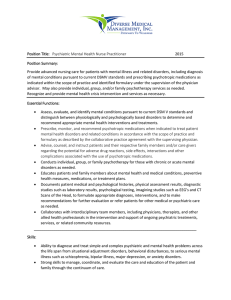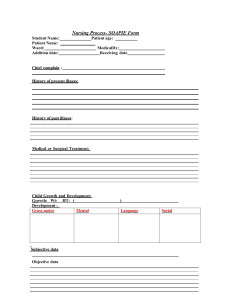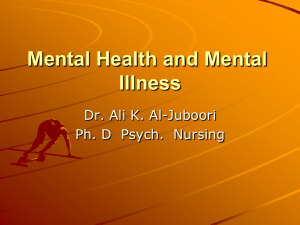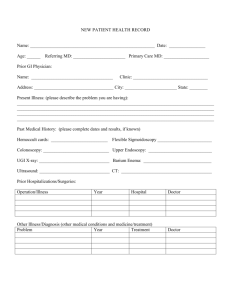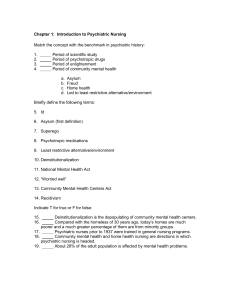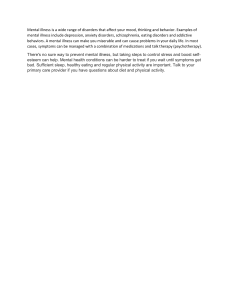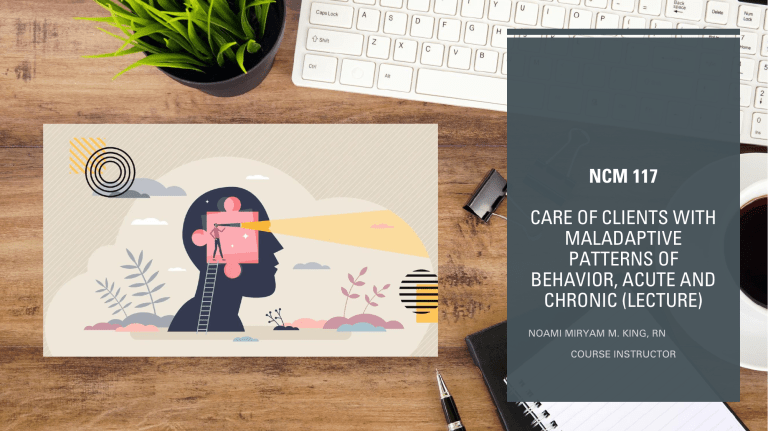
NCM 117 CARE OF CLIENTS WITH MALADAPTIVE PATTERNS OF BEHAVIOR, ACUTE AND CHRONIC (LECTURE) FOUNDATIONS OF PSYCHIATRIC MENTAL HEALTH NURSING LEARNING OBJECTIVES After reading this chapter, you should be able to: 1. Describe the characteristics of mental health and mental illness. 2. Discuss the purpose and use of the American Psychiatric Association’s Diagnostic and Statistical Manual of Mental Disorders, fifth edition (DSM-5). 3. Identify important historical landmarks in psychiatric care. 4. Discuss current trends in the treatment of people with mental illness. 5. Discuss the American Nurses Association (ANA) standards of practice for psychiatric– mental health nursing. 6. Describe the common student concerns about psychiatric nursing. MENTAL HEALTH Mental health is a state of emotional, psychological, and social wellness evidenced by satisfying interpersonal relationships, effective behavior and coping, positive self-concept, and emotional stability. FACTORS INFLUENCING A PERSON’S MENTAL HEALTH Individual Interpersonal Social/cultural MENTAL ILLNESS Mental illness includes disorders that affect mood, behavior, and thinking, such as depression, schizophrenia, anxiety disorders, and addictive disorders. Mental disorders often cause significant distress or impaired functioning or both. DIAGNOSTIC AND STATISTICAL MANUAL OF MENTAL DISORDERS Diagnostic and Statistical Manual of Mental Disorders, fifth edition (DSM-5) The DSM-5 has three purposes: • To provide a standardized nomenclature and language for all mental health professionals • To present defining characteristics or symptoms that differentiate specific diagnoses • To assist in identifying the underlying causes of disorders HISTORICAL PERSPECTIVES OF THE TREATMENT OF MENTAL ILLNESS Ancient Times People of ancient times believed that any sickness indicated displeasure of the gods and, in fact, was a punishment for sins and wrongdoing. Those with mental disorders were viewed as either divine or demonic, depending on their behavior. HISTORICAL PERSPECTIVES OF THE TREATMENT OF MENTAL ILLNESS (CONT.) Aristotle (382–322 BC) attempted to relate mental disorders to physical disorders and developed his theory that the amounts of blood, water, and yellow and black bile in the body controlled the emotions. These four substances, or humors, corresponded with happiness, calmness, anger, and sadness. In early Christian times (1–1000 AD), primitive beliefs and superstitions were strong. All diseases were again blamed on demons, and the mentally ill were viewed as possessed. Priests performed exorcisms to rid sufferers of evil spirits. When that failed, they used more severe and brutal measures, such as incarceration in dungeons, flogging, and starving. In England during the Renaissance (1300–1600), people with mental illness were distinguished from criminals. Those considered harmless were allowed to wander the countryside or live in rural communities, but the more “dangerous lunatics” were thrown in prison, chained, and starved HISTORICAL PERSPECTIVES OF THE TREATMENT OF MENTAL ILLNESS (CONT.) In 1547, the Hospital of St. Mary of Bethlehem was officially declared a hospital for the insane, the first of its kind. By 1775, visitors at the institution were charged a fee for the privilege of viewing and ridiculing the inmates, who were seen as less than human animals. During this same period in the colonies (later the United States), the mentally ill were considered evil or possessed and were punished. Witch hunts were conducted, and offenders were burned at the stake. PERIOD OF ENLIGHTENMENT AND CREATION OF MENTAL INSTITUTIONS In the 1790s, a period of enlightenment concerning persons with mental illness began. Philippe Pinel in France and William Tuke in England formulated the concept of asylum as a safe refuge or haven offering protection at institutions where people had been whipped, beaten, and starved because they were mentally ill. Dorothea Dix (1802–1887) began a crusade to reform the treatment of mental illness after a visit to Tuke’s institution in England. She was instrumental in opening 32 state hospitals that offered asylum to the suffering. Dix believed that society was obligated to those who were mentally ill, she advocated adequate shelter, nutritious food, and warm clothing. PERIOD OF ENLIGHTENMENT AND CREATION OF MENTAL INSTITUTIONS (CONT.) The period of enlightenment was short-lived. Within 100 years after the establishment of the first asylum, state hospitals were in trouble. Attendants were accused of abusing the residents, the rural locations of hospitals were viewed as isolating patients from their families and homes, and the phrase insane asylum took on a negative connotation. SIGMUND FREUD AND TREATMENT OF MENTAL DISORDERS The period of scientific study and treatment of mental disorders began with Sigmund Freud (1856–1939) and others, such as Emil Kraepelin (1856–1926) and Eugen Bleuler (1857–1939). Freud challenged society to view human beings objectively. He studied the mind, its disorders, and their treatment as no one had done before. Kraepelin began classifying mental disorders according to their symptoms Bleuler coined the term schizophrenia. DEVELOPMENT OF PSYCHOPHARMACOLOGY A great leap in the treatment of mental illness began in about 1950 with the development of psychotropic drugs, or drugs used to treat mental illness. Chlorpromazine (Thorazine), an antipsychotic drug, and lithium, an antimanic agent, were the first drugs to be developed. For the first time, drugs actually reduced agitation, psychotic thinking, and depression. Hospital stays were shortened, and many people became well enough to go home. The level of noise, chaos, and violence greatly diminished in the hospital setting. MOVE TOWARD COMMUNITY MENTAL HEALTH The movement toward treating those with mental illness in less restrictive environments gained momentum in 1963 with the enactment of the Community Mental Health Centers Construction Act. Deinstitutionalization, a deliberate shift from institutional care in state hospitals to community facilities, began. In addition to deinstitutionalization, federal legislation was passed to provide an income for disabled persons: supplemental security income (SSI) and Social Security disability income (SSDI). This allowed people with severe and persistent mental illness to be more independent financially and to not rely on family for money. MENTAL ILLNESS IN THE 21ST CENTURY The 18 to 25 age group had the highest prevalence of mental illness as well as the lowest percent of people receiving treatment. Furthermore, mental illness or serious emotional disturbances impair daily activities for an estimated 15 million adults and 4 million children and adolescents. Some believe that deinstitutionalization has had negative as well as positive effects. Although deinstitutionalization reduced the number of public hospital beds by 80%, the number of admissions to those beds correspondingly increased by 90%. Such findings have led to the term revolving door effect. OBJECTIVES FOR THE FUTURE Healthy People 2020 Mental Health Objectives • Reduce the suicide rate. • Reduce suicide attempts by adolescents. • Reduce the proportion of adolescents who engage in disordered eating behaviors in an attempt to control their weight. • Reduce the proportion of persons who experience major depressive episode. • Increase the proportion of primary care facilities that provide mental health treatment onsite or by paid referral. • Increase the proportion of juvenile residential facilities that screen admissions for mental health problems. • Increase the proportion of persons with serious mental illness who are employed. • Increase the proportion of adults with mental health disorders who receive treatment. • Increase the proportions of persons with co-occurring substance abuse and mental disorders who receive treatment for both disorders. • Increase depression screening by primary care providers. • Increase the number of homeless adults with mental health problems who receive mental health services. COMMUNITY-BASED CARE Community support service programs were developed to meet the needs of persons with mental illness outside the walls of an institution. These programs focus on rehabilitation, vocational needs, education, and socialization as well as on management of symptoms and medication. These services are funded by states or counties and some private agencies. Therefore, the availability and quality of services vary in different areas of the country. The community-based system did not accurately anticipate the extent of the needs of people with severe and persistent mental illness. Many clients do not have the skills needed to live independently in the community, and teaching these skills is often timeconsuming and labor-intensive, requiring a 1:1 staff to-client ratio. In addition, the nature of some mental illnesses makes learning these skills more difficult. COST CONTAINMENT AND MANAGED CARE Managed care is a concept designed to purposely control the balance between the quality of care provided and the cost of that care. In the 1990s, a new form of managed care was developed by utilization review firms or managed care organizations to control the expenditure of insurance funds by requiring providers to seek approval before the delivery of care. Psychiatric care is costly because of the long-term nature of the disorders. PSYCHIATRIC NURSING PRACTICE In 1873, Linda Richards graduated from the New England Hospital for Women and Children in Boston. She went on to improve nursing care in psychiatric hospitals and organized educational programs in state mental hospitals in Illinois. Richards is called the first American psychiatric nurse; she believed that “the mentally sick should be at least as well cared for as the physically sick” The first training of nurses to work with persons with mental illness was in 1882 at McLean Hospital in Belmont, Massachusetts. The care was primarily custodial and focused on nutrition, hygiene, and activity. The first psychiatric nursing textbook, Nursing Mental Diseases by Harriet Bailey, was published in 1920. In 1913, Johns Hopkins was the first school of nursing to include a course in psychiatric nursing in its curriculum. It was not until 1950 that the National League for Nursing, that accredits nursing programs, required schools to include an experience in psychiatric nursing. PSYCHIATRIC NURSING PRACTICE (CONT.) Two early nursing theorists shaped psychiatric nursing practice: Hildegard Peplau and June Mellow. Peplau published Interpersonal Relations in Nursing in 1952 and Interpersonal Techniques: The Crux of Psychiatric Nursing in 1962. Mellow’s 1968 work, Nursing Therapy, described her approach of focusing on clients’ psychosocial needs and strengths. PSYCHIATRIC NURSING PRACTICE (CONT.) The American Nurses Association (ANA) develops standards of care, which are revised as needed. Standards of care are authoritative statements by professional organizations that describe the responsibilities for which nurses are accountable. The American Psychiatric Nurses Association (APNA) has standards of practice and standards of professional performance. These also outline the areas of practice and phenomena of concern for today’s psychiatric–mental health nurse. The phenomena of concern describe the 13 areas of concern that mental health nurses focus on when caring for clients. Psychiatric–Mental Health Nursing Phenomena of Concern Phenomena of concern for psychiatric–mental health nurses include: • Promotion of optimal mental and physical health and well-being and prevention of mental illness • Impaired ability to function related to psychiatric, emotional, and physiologic distress • Alterations in thinking, perceiving, and communicating because of psychiatric disorders or mental health problems • Behaviors and mental states that indicate potential danger to self or others • Emotional stress related to illness, pain, disability, and loss • Symptom management, side effects, or toxicities associated with self administered drugs, psychopharmacologic intervention, and other treatment modalities PSYCHIATRIC–MENTAL HEALTH NURSING PHENOMENA OF CONCERN •The barriers to treatment efficacy and recovery posed by alcohol and substance abuse and dependence • Self-concept and body image changes, developmental issues, life process changes, and endof-life issues • Physical symptoms that occur along with altered psychological status • Psychological symptoms that occur along with altered physiologic status • Interpersonal, organizational, sociocultural, spiritual, or environmental circumstances or events that have an effect on the mental and emotional well-being of the individual and family or community • Elements of recovery, including the ability to maintain housing, employment, and social support, that help individuals reengage in seeking meaningful lives • Societal factors such as violence, poverty, and substance abuse STUDENT CONCERNS 1. 2. 3. 4. 5. 6. 7. 8. 9. What if I say the wrong thing? What will I be doing? What if no one will talk to me? Am I prying when I ask personal questions? How will I handle bizarre or inappropriate behavior? What happens if a client asks me for a date or displays sexually aggressive or inappropriate behavior? Is my physical safety in jeopardy? What if I encounter someone I know being treated on the unit? What if I recognize that I share similar problems or backgrounds with clients? SELF-AWARENESS ISSUES Self-awareness is the process by which the nurse gains recognition of his or her own feelings, beliefs, and attitudes. In nursing, being aware of one’s feelings, thoughts, and values is a primary focus. Self-awareness is particularly important in mental health nursing. Everyone, including nurses and student nurses, has values, ideas, and beliefs that are unique and different from those of others. POINTS TO CONSIDER WHEN WORKING ON SELFAWARENESS • Keep a diary or journal that focuses on experiences and related feelings. • Talk with someone you trust about your experiences and feelings. • Engage in formal clinical supervision. • Seek alternative points of view. • Do not be critical of yourself (or others) for having certain values or beliefs. NEUROBIOLOGIC THEORIES AND PSYCHOPHARMACOLOGY LEARNING OBJECTIVES After reading this chapter, you should be able to: 1. Discuss the structures, processes, and functions of the brain. 2. Identify pertinent teaching for clients and families about brain imaging techniques. 3. Describe the current neurobiologic research and theories that are the basis for current psychopharmacologic treatment of mental disorders. 4. Discuss the nurse’s role in educating clients and families about current neurobiologic theories and medication management. 5. Discuss the categories of drugs used to treat mental illness and their mechanisms of action, side effects, and special nursing considerations. 6. Identify client responses that indicate treatment effectiveness. 7. Discuss common barriers to maintaining the medication regimen. 8. Develop a teaching plan for clients and families for implementation of the prescribed therapeutic regimen. THE NERVOUS SYSTEM AND HOW IT WORKS • • • • Cerebrum Cerebellum Brain Stem Limbic System NEUROTRANSMITTERS Approximately 100 billion brain cells form groups of neurons, or nerve cells, that are arranged in networks. These neurons communicate information with one another by sending electrochemical messages from neuron to neuron, a process called neurotransmission. Neurotransmitters are the chemical substances manufactured in the neuron that aid in the transmission of information throughout the body. Major neurotransmitters have been found to play a role in psychiatric illnesses as well as in the actions and side effects of psychotropic drugs. BRAIN IMAGING TECHNIQUES LIMITATIONS OF BRAIN IMAGING TECHNIQUES •The use of radioactive substances in PET and SPECT limits the number of times a person can undergo these tests. There is the risk that the client will have an allergic reaction to the substances. Some clients may find receiving intravenous doses of radioactive material frightening or unacceptable. • Imaging equipment is expensive to purchase and maintain, so availability can be limited. • Some persons cannot tolerate these procedures because of fear or claustrophobia. • Researchers are finding that many of the changes in disorders such as schizophrenia are at the molecular and chemical levels and cannot be detected with current imaging techniques (Gur & Gur, 2017). NEUROBIOLOGIC CAUSES OF MENTAL ILLNESS ❑Genetics and Heredity ❑Stress and the Immune System (Psychoimmunology) ❑Infection as a Possible Cause PSYCHOPHARMACOLOGY Principles that Guide Pharmacologic Treatment • A medication is selected based on its effect on the client’s target symptoms such as delusional thinking, panic attacks, or hallucinations. • Many psychotropic drugs must be given in adequate dosages for some time before their full effects are realized. • The dosage of medication is often adjusted to the lowest effective dosage for the client. Sometimes a client may need higher dosages to stabilize his or her target symptoms, while lower dosages can be used to sustain those effects over time. • As a rule, older adults require lower dosages of medications than do younger clients to experience therapeutic effects. It may also take longer for a drug to achieve its full therapeutic effect in older adults. • Psychotropic medications are often decreased gradually (tapering) rather than abruptly. This is because of potential problems with rebound (temporary return of symptoms), recurrence (of the original symptoms), or withdrawal (new symptoms resulting from discontinuation of the drug). • Follow-up care is essential to ensure compliance with the medication regimen, to make needed adjustments in dosage, and to manage side effects. • Compliance with the medication regimen is often enhanced when the regimen is as simple as possible in terms of both the number of medications prescribed and the number of daily doses. PSYCHOPHARMACOLOGY ✓ Antipsychotic Drugs ✓ Antidepressant Drugs ✓ Mood Stabilizing Drugs ✓ Antianxiety Drugs (Anxiolytics) ✓ Stimulants ✓ Disulfiram (Antabuse) ANTIPSYCHOTIC DRUGS Antipsychotic drugs, formerly known as neuroleptics, are used to treat the symptoms of psychosis, such as the delusions and hallucinations seen in schizophrenia, schizoaffective disorder, and the manic phase of bipolar disorder. Mechanism of Action: Antipsychotic medications work by altering brain chemistry to help reduce psychotic symptoms like hallucinations, delusions and disordered thinking. They can also help prevent those symptoms from returning. ANTIPSYCHOTIC DRUGS (CONT.) Conventional or first-generation antipsychotics Phenothiazines Chlorpromazine (Thorazine) Perphenazine (Trilafon) Fluphenazine (Prolixin) Thioridazine (Mellaril) Mesoridazine (Serentil) Trifluoperazine (Stelazine) Thioxanthene Thiothixene (Navane) Butyrophenones Haloperidol (Haldol) Droperidol (Inapsine) Dibenzazepine Loxapine (Loxitane) Dihydroindolone Molindone (Moban) Atypical or second-generation antipsychotics Clozapine (Clozaril) Fazaclo (clozapine) Risperidone (Risperdal) Olanzapine (Zyprexa) Quetiapine (Seroquel) Ziprasidone (Geodon) Paliperidone (Invega) Iloperidone (Fanapt) Asenapine (Saphris) Lurasidone (Latuda) Third-generation antipsychotics Aripiprazole (Abilify) Cariprazine (Vraylar) Brexpiprazole (Rexulti) ANTIPSYCHOTIC DRUGS (CONT.) Side Effects: 1. Extrapyramidal Side Effects 2. Neuroleptic Malignant Syndrome. 3. Anticholinergic Side Effects ANTIPSYCHOTIC DRUGS (CONT.) Client Teaching: • The nurse informs clients taking antipsychotic medication about the types of side effects that may occur and encourages clients to report such problems. • The nurse teaches the client methods of managing or avoiding unpleasant side effects and maintaining the medication regimen • Clients should monitor the amount of sleepiness or drowsiness they feel. They should avoid driving and performing other potentially dangerous activities until their response times and reflexes seem normal. • The nurse encourages clients who have difficulty remembering to take their medication to use a chart and to record doses when taken or to use a pillbox that can be prefilled with accurate doses for the day or week. ANTIDEPRESSANT DRUGS Selective serotonin reuptake inhibitors Fluoxetine (Prozac) Fluvoxamine (Luvox) Paroxetine (Paxil) Sertraline (Zoloft) Citalopram (Celexa) Escitalopram (Lexapro) Cyclic compounds Imipramine (Tofranil) Desipramine (Norpramin) Amitriptyline (Elavil) Nortriptyline (Pamelor) Doxepin (Sinequan) Trimipramine (Surmontil) Protriptyline (Vivactil) Maprotiline (Ludiomil) Mirtazapine (Remeron) Amoxapine (Asendin) Clomipramine (Anafranil) Other compounds Bupropion (Wellbutrin) Venlafaxine (Effexor) Desvenlafaxine (Pristiq) Trazodone (Desyrel) Nefazodone (Serzone) Duloxetine (Cymbalta) Vilazodone (Viibryd) Monoamine oxidase inhibitors Phenelzine (Nardil) Tranylcypromine (Parnate) Isocarboxazid (Marplan) ANTIDEPRESSANT DRUGS (CONT.) Preferred Drugs for Clients at High Risk for Suicide Suicide is always a primary consideration when treating clients with depression. Mechanism of Action: The precise mechanism by which antidepressants produce their therapeutic effects is not known, but much is known about their action on the CNS. The major interaction is with the monoamine neurotransmitter systems in the brain, particularly norepinephrine and serotonin. ANTIDEPRESSANT DRUGS (CONT.) Side Effects of Selective Serotonin Reuptake Inhibitors Anxiety, agitation, akathisia (motor restlessness), nausea, insomnia, and sexual dysfunction, specifically diminished sexual drive or difficulty achieving an erection or orgasm. Side Effects of Cyclic Antidepressants Dry mouth, constipation, urinary hesitancy or retention, dry nasal passages, and blurred near vision, orthostatic hypotension, sedation, weight gain, and tachycardia. ANTIDEPRESSANT DRUGS (CONT.) Side Effects of Monoamine Oxidase Inhibitors Daytime sedation, insomnia, weight gain, dry mouth, orthostatic hypotension, and sexual dysfunction. Foods to Avoid When Taking Monoamine Oxidase Inhibitors • Mature or aged cheeses or dishes made with cheese, such as lasagna or pizza. All cheese is considered aged except cottage cheese, cream cheese, ricotta cheese, and processed cheese slices. • Aged meats such as pepperoni, salami, mortadella, summer sausage, beef logs, meat extracts, and similar products. Make sure meat and chicken are fresh and have been properly refrigerated. • Italian broad beans (fava), bean curd (tofu), banana peel, overripe fruit, and avocado. • All tap beers and microbrewery beer. Drink no more than two cans or bottles of beer (including nonalcoholic beer) or 4 oz of wine per day. • Sauerkraut, soy sauce or soybean condiments, or marmite (concentrated yeast). • Yogurt, sour cream, peanuts, brewer’s yeast, and monosodium glutamate (MSG). ANTIDEPRESSANT DRUGS (CONT.) Client Teaching Clients should exercise caution when driving or performing activities requiring sharp, alert reflexes until sedative effects can be determined. MOOD-STABILIZING DRUGS Mood-stabilizing drugs are used to treat bipolar disorder by stabilizing the client’s mood, preventing or minimizing the highs and lows that characterize bipolar illness, and treating acute episodes of mania. Lithium is the most established mood stabilizer, some anticonvulsant drugs, particularly carbamazepine (Tegretol) and valproic acid (Depakote, Depakene), are effective mood stabilizers. Other anticonvulsants, such as gabapentin (Neurontin), topiramate (Topamax), oxcarbazepine (Trileptal), and lamotrigine (Lamictal), are also used for mood stabilization. MOOD-STABILIZING DRUGS (CONT.) Side Effects Common side effects of lithium therapy include mild nausea or diarrhea, anorexia, fine hand tremor, polydipsia, polyuria, a metallic taste in the mouth, and fatigue or lethargy. Toxic effects of lithium are severe diarrhea, vomiting, drowsiness, muscle weakness, and lack of coordination. Side effects of carbamazepine and valproic acid include drowsiness, sedation, dry mouth, and blurred vision. MOOD-STABILIZING DRUGS (CONT.) Client Teaching For clients taking lithium and the anticonvulsants, monitoring blood levels periodically is important. Taking these medications with meals minimizes nausea. The client should not attempt to drive until dizziness, lethargy, fatigue, or blurred vision has subsided. ANTIANXIETY DRUGS (ANXIOLYTICS) Antianxiety drugs, or anxiolytic drugs, are used to treat anxiety and anxiety disorders, insomnia, obsessive-compulsive disorder (OCD), depression, posttraumatic stress disorder, and alcohol withdrawal. Benzodiazepines have proved to be the most effective in relieving anxiety and are the drugs most frequently prescribed. Benzodiazepines may also be prescribed for their anticonvulsant and muscle relaxant effects. Side Effects The side effects commonly reported with benzodiazepines are those associated with CNS depression, such as drowsiness, sedation, poor coordination, and impaired memory or clouded sensorium. ANTIANXIETY DRUGS (ANXIOLYTICS) (CONT.) Client Teaching Clients need to know that antianxiety agents are aimed at relieving symptoms such as anxiety or insomnia but do not treat the underlying problems that cause the anxiety. Clients should be aware of decreased response time, slower reflexes, and possible sedative effects of these drugs when attempting activities such as driving or going to work. STIMULANTS Stimulant drugs, specifically amphetamines, were first used to treat psychiatric disorders in the 1930s for their pronounced effects on CNS stimulation. Today, the primary use of stimulants is for ADHD in children and adolescents, residual attentiondeficit disorder in adults, and narcolepsy. Drugs Used to Treat Attention-Deficit/Hyperactivity Disorder Methylphenidate (Ritalin) Sustained release (Ritalin-SR, Concerta, Metadate-CD) Transdermal patch (Daytrana) Dextroamphetamine (Dexedrine) Sustained release (Dexedrine-SR) Amphetamine (Adderall) Sustained release (Adderall-SR) Pemoline (Cylert) Atomoxetine (Strattera) STIMULANTS (CONT.) Side Effects The most common side effects of stimulants are anorexia, weight loss, nausea, and irritability. The client should avoid caffeine, sugar, and chocolate, which may worsen these symptoms. Less common side effects include dizziness, dry mouth, blurred vision, and palpitations. Client Teaching Taking doses of stimulants after meals may minimize anorexia and nausea. Caffeinefree beverages are suggested, clients should avoid chocolate and excessive sugar DISULFIRAM (ANTABUSE) Disulfiram is a sensitizing agent that causes an adverse reaction when mixed with alcohol in the body. This agent’s only use is as a deterrent to drinking alcohol in persons receiving treatment for alcoholism. It is useful for persons who are motivated to abstain from drinking and who are not impulsive. Education is extremely important for the client taking disulfiram. Many common products such as shaving cream, aftershave lotion, cologne, deodorant, and OTC medications such as cough preparations contain alcohol, when used by the client taking disulfiram, these products can produce the same reaction as drinking alcohol. The client must read product labels carefully and select items that are alcohol free. PSYCHOSOCIAL THEORIES AND THERAPY LEARNING OBJECTIVES After reading this chapter, you should be able to: 1. Explain the basic beliefs and approaches of the following psychosocial theories: psychoanalytic, developmental, interpersonal, humanistic, behavioral, existential, and crisis intervention. 2. Describe the following psychosocial treatment modalities: individual psychotherapy, group psychotherapy, family therapy, behavior modification, systematic desensitization, token economy, self-help groups, support groups, education groups, cognitive therapy, milieu therapy, and psychiatric rehabilitation. 3. Identify the psychosocial theory on which each treatment strategy is based. 4. Identify how several of the theoretical perspectives have influenced current nursing practice. This chapter discusses the following types of psychosocial theories: • Psychoanalytic • Developmental • Interpersonal • Humanistic • Behavioral • Existential PSYCHOANALYTIC THEORIES Sigmund Freud: The Father of Psychoanalysis
